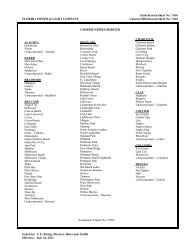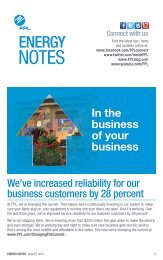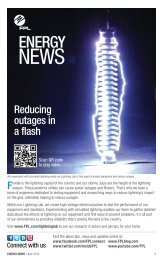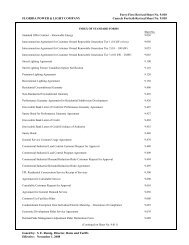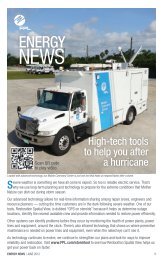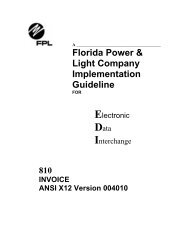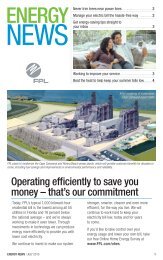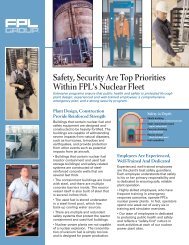Your Electric Bill - FPL.com
Your Electric Bill - FPL.com
Your Electric Bill - FPL.com
Create successful ePaper yourself
Turn your PDF publications into a flip-book with our unique Google optimized e-Paper software.
<strong>Your</strong> <strong>Electric</strong> <strong>Bill</strong>A Guide for Residential Customers
Florida Power & Light Companywill lower the typical residentialcustomer bill in 2009• Effective Jan. 6, 2009, the typical 1,000 kilowatt-hour residentialcustomer bill will be $109.55*, a reduction of 1.4 percent fromDecember 2008. This is due to a lower 2009 fuel charge, reflectinga recent reduction in prices in fuel markets.• The fuel charge – representing the cost of natural gas and fuel oil<strong>FPL</strong> must purchase to generate electricity for its customers – is apass-through charge on which <strong>FPL</strong> makes no profit.<strong>FPL</strong> is investing and keeping bills low• We’re investing to make our infrastructure stronger, smarter, cleaner,more efficient and less reliant on any single source of fuel. Theseinvestments help to reduce the impact of volatile fuel prices over thelonger term, which in turn keeps customer bills lower over the longterm as well.• According to the most recent data available from the FloridaMunicipal <strong>Electric</strong> Association and Edison <strong>Electric</strong> Institute, <strong>FPL</strong> billsare 13 percent lower than the average electric bill in Florida and 17percent lower than the national average, despite <strong>FPL</strong> having madeinvestments that make the <strong>com</strong>pany one of the cleanest energygenerators in the United States.*<strong>Bill</strong> amounts will vary based on actual usage. The percentage may be higher ifyou consume more than 1,000 kilowatt hours.2
Energy-saving advice from <strong>FPL</strong><strong>FPL</strong> is <strong>com</strong>mitted to helping its customers manage their electricity usage.As a first step, residential customers can visit www.<strong>FPL</strong>.<strong>com</strong> under theEnergy Savings Toolkit section and take an online Home Energy Survey tofind out how they can make their homes more energy efficient.<strong>FPL</strong> also offers its customers tips they can use to control their energy usein cooler weather months. For example:• If you switch your air conditioner to the heating mode on the coldestdays of the year, keep the thermostat set at 68 degrees. Reduce thesetting to 65 degrees when leaving the home or while sleeping foreven more energy efficiency.• Install a programmable thermostat to automate the task of raisingand lowering the thermostat on central heating (and cooling)systems. This also helps to maintain a <strong>com</strong>fortable home to wakeup in on chilly mornings.• Set ceiling fans in “reverse” mode to circulate warm air downward.Turn the fan off when you leave the room for further economy. A fanthat runs constantly can cost up to $7 a month depending on sizeand age.• Install low-flow showerheads to reduce hot water used during long,cool-weather showers. These showerheads can pay for themselves inas little as a few weeks.• Eliminate energy-wasting drafts around exterior doors by installingvinyl weather-stripping. Add rubber door sweeps to the bottom ofdoors and thresholds to keep cool air outside.• Avoid pre-rinsing dishes before putting them in dishwasher. It cansave up to $70 a year.• Limit the time you run your pool pump to six hours a day in summerand four a day in winter.• Adjust the water level on your washing machine to match the loadsize, especially when using hot water. Always use a cold rinse.• Clean the lint filter in your dryer before every load to dry your clothesfaster and save money.• Use the auto sensor function on your dryer, if you have one, toconserve energy by not over-drying your clothes.3
Take control of your electric bill byenrolling in <strong>FPL</strong> programsYou can also control more of your energy usage and better manage yourelectric bill by taking advantage of these <strong>FPL</strong> programs.• <strong>FPL</strong>’s Online Home Energy Survey gives you a personalized analysis ofyour home’s energy usage, along with tips and re<strong>com</strong>mendations forlow-cost and no-cost ways to make your home more energy-efficientand save on electricity. Visit www.<strong>FPL</strong>.<strong>com</strong>/ohes to learn more.• You can sign up for <strong>FPL</strong>’s Budget <strong>Bill</strong>ing program. Although not asavings program, this free program helps smooth out the ups anddowns of seasonal energy use and changes in fuel costs. Of course,you will still need to monitor your energy usage and continue toconserve. Visit www.<strong>FPL</strong>.<strong>com</strong>/resbb to learn more about Budget<strong>Bill</strong>ing.• When you <strong>com</strong>bine <strong>FPL</strong> Budget <strong>Bill</strong>ing with <strong>FPL</strong> Automatic <strong>Bill</strong> Pay,your bill is paid automatically, on time, every month. Plus, you willnever have to worry about a higher-than-expected amount beingwithdrawn from your bank account. That’s because you’ll pay aboutthe same amount year-round. Visit www.<strong>FPL</strong>.<strong>com</strong>/autopay to learnmore about Automatic <strong>Bill</strong> Pay.13079_RESB_08114



